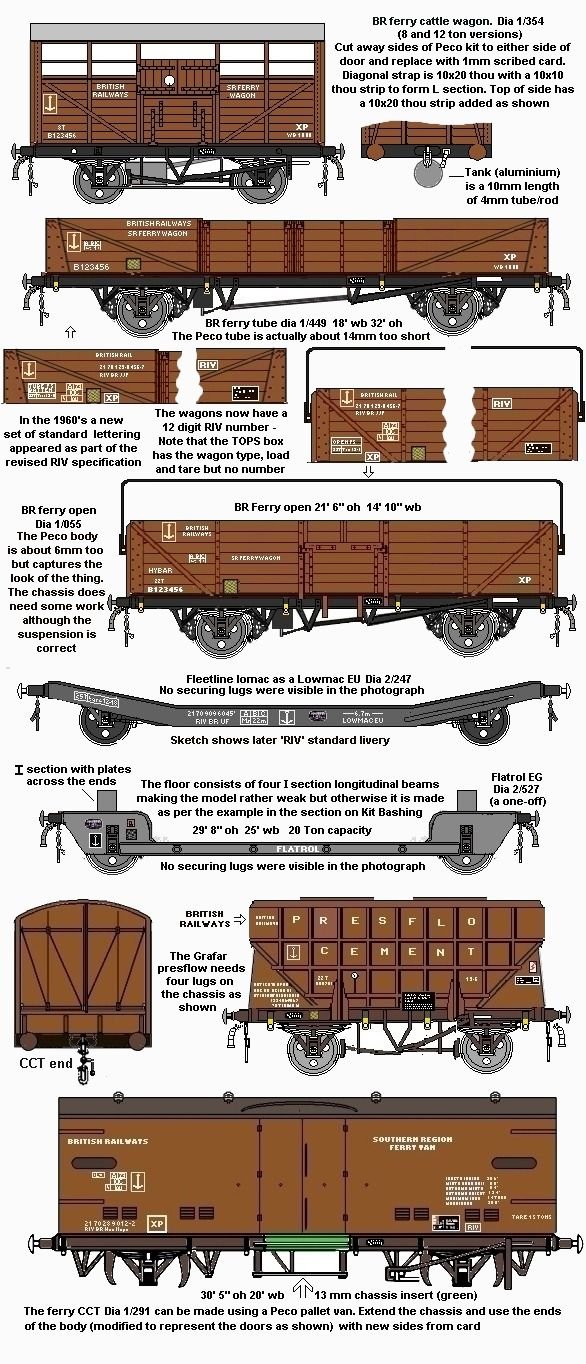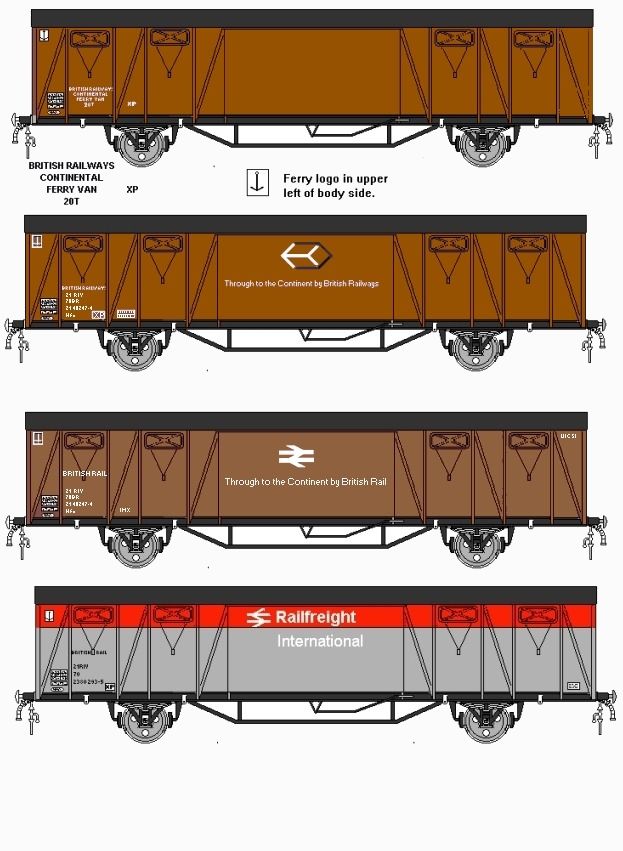Ferry Wagon Liveries
NB The colours used were obtained by sampling colour pictures, they
may however vary from the true colour, use as a rough guide only
Goods stock for international trades using the North Sea and Channel
train ferry services has to comply with the requirements of all countries it
will visit on its travels. The rules relating to international rail operations are laid down by the International Union of Railways (UIC), founded in 1922. This organisation introduced a uniform numbering system in (I believe) the 1960s (discussed below)
To match the differing systems in Britain and on the
continent British ferry stock needed both vacuum and air brakes, or at least a through
air pipe for the alternative system. The chassis is fitted with securing lugs to
allow the vehicles to be chained down to the ships deck in transit, roller
bearings have been standard since the 1950's at least, screw couplings are
always fitted and the buffers, until the later 1970's, were heavier than those
on normal British stock. The international screw coupling was longer than the standard British coupling so buffers were also longer on British ferry stock. Not all vehicles used on the ferries were fully
equipped for international travel, some British vehicles were only partially
modified and hence did not carry the full set of ferry markings.
British ferry stock was painted in standard freight colours. Note the
securing lugs, four per side attached to the chassis, are sometimes not painted
but those that were either yellow or white (I think yellow was the norm).
These were used for chaining the vehicle down on the deck of the ferry. After
the ferry stock was transferred to general service use in 1982 the lugs were
painted over with black chassis colour.
There was an excellent article on ferry rolling stock in the 1985 Model
Railway Constructor Annual which includes scale drawings for the long wheelbase
van and several useful illustrations of British owned tank and railway company
wagons in ferry liveries. For details see the Bibliography.
The full UIC international specification for ferry stock is called RIV and
these letters appear prominently on the sides of all such stock, however a lot of British stock does not meet the requirements for full RIV operation. To indicate a vehicle used for international work that can fit the restricted British loading gauge the 'anchor in a box' symbol was adopted. The anchor does not mean the vehicle
conforms to the full RIV specification and BR operated a number of vehicles
only partly modified for ferry use which had the anchor marking but which did not carry the RIV branding or the full set of UIC markings.
The UIC wagon numbering system is rather complicated but Brian Williams, a regular on the uk.rec.models.rail newsgroup, and Torsten Jerzembeck both supplied details of the system to allow me to correct my original description. I am most grateful for the clarification they supplied, any errors in the description that follows are entirely my own.
As noted above international
services have their own numbering system, called the exchange code, introduced (I believe) in the 1960's. This code was changed in about 1980, so you need to check with photographs to get that accurate.
The first two digits identify things
such as :- two-axle vehicle which may be used on both Iberian and standard
gauges, four-axle ditto, whether a wagon may be used on any UIC railway or
whether it is subject to exceptions, whether a wagon is privately-owned or
not etc. Up to about 1980 the second pair of digits identifies the railway administration
with which the wagon is registered. There then follow a sequence of numbers
which give the broad general type of vehicle and its running number, finally the last
digit is separated by a hyphen and serves as a computer check.
In 1980 mean the meaning of (some of) the first two digit codes has changed, the second group now identifies the country, the third group identifies the owner of the vehicle. So (in 2007) you might see 80 _D_-DB" instead of "80 DB", and also "80 _D_-somethingelse
If a wagon does not fulfil all
technical standards set out in the RIV, but some railways agree to
accept it onto their network, the abbreviations of those railways are
written on the wagon like this:
+------------+-------+
| DDD BBB | NS |
| D D B B |-------+
| D D BBB | SNCB |
| D D B B |-------+
| DDD BBB | SNCF |
+------------+-------+
(Proper drawing to follow when completed) In this example it indicates a wagon of the DB, allowed to run on the networks of
the NS [Netherlands], SNCB [Belgium] and SNCF [France].)
Regarding the RIV and boxed anchor: The letters RIV on a wagon or van signifies that the wagon can run on all networks that are part of the RIV agreement, except for the network of the BR. A wagon that is able to run on the BR network bears the boxed anchor in addition to the RIV and this symbol remains in use for stock operting through the Channel Tunnel.
Some markings, such as 'Hazchem' symbols are to internationally agreed standards.
The few pre-nationalisation ferry stock liveries I have managed to trace (all Southern Railway)
are illustrated in the section on Rolling Stock Design - Ferry Wagons, the
sketch below shows a selection of BR era ferry stock liveries.
Fig___ BR Ferry stock liveries

The Lowmac EU was an unfitted type, equipped with a through air
pipe for ferry work. I am not sure of the body colour as some piped vehicles
were painted bauxite but I believe grey would be more likely. The ferry van is
a short variant of the BR CCT (Covered Carriage Truck) with a twenty foot
wheelbase and a body just under thirty one feet long. It can be modelled using
a Peco pallet van kit by extending the chassis by 10mm (the extension is shown
green in the sketch) and using the ends and floor of the body. Modelling this
van is described in the section on Kit Bashing. The lettering shown is based on
a photograph on John Turner's web site (see App 7 Useful Links). Most of the
lettering can be represented by white dots, covered with a wash of dirty
thinners weathering this should pass muster at 'normal viewing distance' in N.
Note that the securing lugs were not painted on the vehicle in the
photograph.
In the case of wagons and vans these markings are on the vehicle sides,
on tank wagons they are usually on a large metal panel mounted on top of the
chassis toward the left hand end to match European regulations. Where a wagon
does not have a suitable place for the markings they might be painted on the
ends or on a metal plate similar to those seen on the tank wagons but mounted
below the solebar so as not to obstruct access to the wagon.
The basic livery for the British long wheelbase ferry vans shows most of
these features, although several of these vans were never re-numbered in the
international series. The basic body colour was Bauxite with white markings
until the change to Railfreight livery in the early 1980's when the red and
grey layout was introduced.
Fig ___ British Long Wheelbase Ferry Vans

Bernard Taylor described the scratch building of a model of this van in
one of his articles for Practical Model Railways magazine (for details see
Bibliography). The main problem is the wheelbase, if the model is built rigid
the minimum curve it will negotiate is in the region of two foot (60cm) radius.
Mr. Taylor used a continental long wheelbase chassis with pivoted wheelsets for
his model. I gather that a card model of this van has now been introduced in N Gauge, however I have not yet seen one and canot comment on the design of the model.
There were a small number of Freightliner flat wagons modified for ferry
use, these operated a limited service between the UK and France, they have been
illustrated and described in the section on Freight Operations - Ferry
Services. They were in regular ferry use in the 1970s but (I believe) normally only got as far North as London. Inner and outer vehicles were used but rakes could be as short as two outer vehicles coupled together.
Fig ___ Ferry equipped Freightliner flats

Ferry tank wagons often resemble European vehicles, they have the large
data plate to the lower left mounted on top of the chassis. This plate is
painted black and has white markings but on some BR tanks, when withdrawn from
ferry service, these plates were painted red with white markings relating to
the cargo carried.
Fig ___ Ferry tank wagons and markings

There were once regular sleeping coach services between London and
Paris which were carried by the cross channel ferry from Dover but these used
French Wagon Lit (literally 'bed wagon') coaches built to suit the British
loading gauge (given that Continental models are to 1-160 scale you could get
away with using them in British N, these trains had distinctive four wheeled
brake vans, an illustration will be found in the section on Freight Operations
- Ferry Traffic). They were hauled to the Dover ferry berth by a British
locomotive and collected on the French side by a French loco. In the 1980's BR
painted some passenger coaches in Sealink livery to promote their
Scotland-Ireland services, the Irish railways also painted some stock in a
similar livery. I only recently heard of these coaches but an enquiry on the
uk.railways newsgroup provided details of their use and livery. They were
introduced in 1982 or possibly 83 and remained in service until 1986. One
contributor was able to advise-
The intention seems to have been to promote the 'seamless
journey' opportunities available by rail and boat between Glasgow and Belfast.
Northern Ireland Railways also painted a train into Sealink livery at this
time, and used it between Larne Harbour and Belfast (York Road). This was a
three-coach 70-class DEMU, which ran in this livery from April 1983 until
withdrawal in October 1985.
The NIR version of Sealink livery also
included a lot of red - bright red above the waist, with three-tone (!) blue
below. Presumably it was based upon the then-current NIR livery of maroon above
the waist and dark blue below.
In October 1982, Douglas Horse Tramway car
1 was painted into Sealink livery. It was used to promote their Heysham -
Douglas service at various tourism events in Britain that winter. It returned
to the Isle of Man in March 1983, and ran in Sealink livery for a couple of
years.
-- MetroGnome
Fig___ Sealink coach livery

My sketch is based on the Lima
OO scale model and may be inaccurate. Lima produced a brake-second and an open
tourist second coach in this livery I believe.
For further details of their operational use see the section
on Railway Freight Operations - Ferry Traffic.
The 'Venice Simplon
Orient Express' is a privately run service, started in 1982 and still (I
believe) operating today (2003). This train uses restored 1920's Pullman stock
for the run from London to Dover where people board a ferry to cross the
channel and then proceed on similarly first class restored Wagon Lits stock to
Venice. There are several 'real' orient express services in Europe, dating back
to the late 19th century, but non of these had a UK leg.
^
Go to top of page
International Good Guys ~ Making the world a
better place since 1971 ~ Site maintained by

All material Copyright © Mike
Smith 2003 unless otherwise credited




